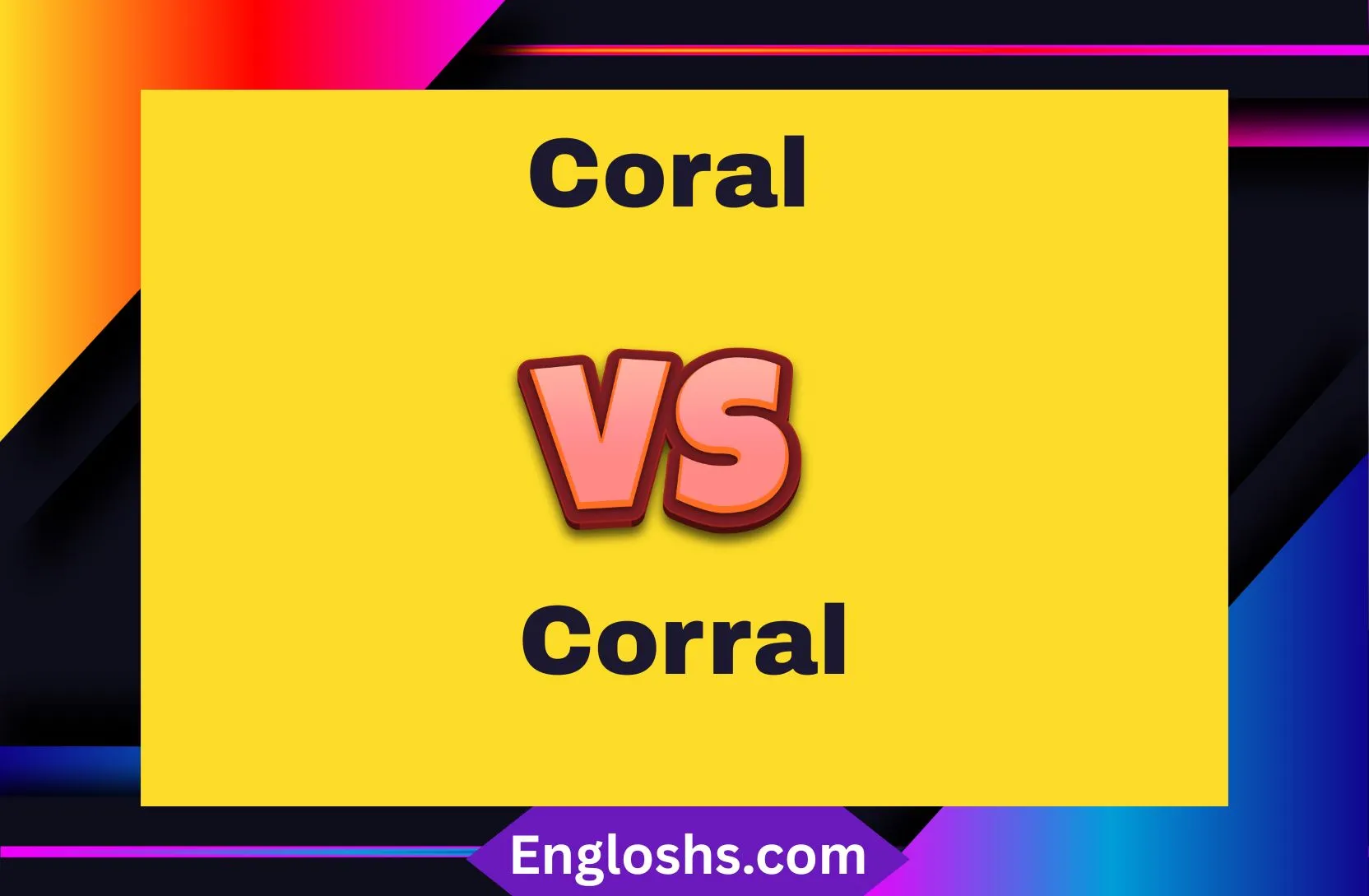At first glance, coral and corral may look and sound similar. But don’t let their near-identical spellings fool you—they belong to completely different worlds. One thrives beneath the sea, vibrant and vital to marine life.
The other is rooted in cowboy culture, corralling livestock on dry land. Confusing these two can lead to more than a spelling error—it can change the entire meaning of a sentence.
In this article, you’ll uncover the real differences between coral and corral, complete with clear definitions, visual comparisons, pronunciation tips, and helpful tricks to keep them straight. Let’s dive in.
“Coral” refers to marine animals or a pinkish color, while “corral” is an enclosure for livestock—distinct in meaning, spelling, and use.
Understanding the Meaning of Coral
Coral refers to marine invertebrates that build large, colorful underwater structures. When most people hear the word, they think of coral reefs—bright, biodiverse underwater cities. But coral also refers to a pinkish-orange color in fashion and design.
Definition and Structure of Coral
Coral is made up of tiny animals called polyps, which belong to the phylum Cnidaria. These polyps secrete calcium carbonate to build hard, protective skeletons. Over time, thousands of polyps form vast reef structures.
“Corals are not rocks or plants—they’re living animals forming the foundation of marine ecosystems.”
Types of Corals
Corals come in various shapes and species. Here’s a look at the two major types:
| Type of Coral | Description | Examples |
|---|---|---|
| Hard (Stony) Coral | Builds reefs; secretes calcium carbonate | Brain coral, Elkhorn coral |
| Soft Coral | Flexible, lacks hard skeletons | Sea fans, Sea whips |
Coral Reefs and Their Importance
Coral reefs support 25% of all marine species despite covering less than 1% of the ocean floor. They’re often called the “rainforests of the sea” due to their biodiversity.
Why Coral Reefs Matter:
- Provide habitat for fish and marine life
- Protect coastlines from erosion and storms
- Support tourism and fishing industries
- Absorb carbon dioxide, reducing climate change impact
Coral Reproduction and Growth
Corals reproduce both sexually and asexually.
- Sexual reproduction involves spawning, where eggs and sperm are released into the water.
- Asexual reproduction occurs when new polyps bud from parent polyps, expanding the reef.
Growth is slow—some corals grow just 0.3 to 2 centimeters per year, yet reefs can reach massive sizes over centuries.
Examples of Coral Usage
- “She wore a coral necklace that shimmered under the lights.”
- “Scientists are studying coral bleaching caused by rising sea temperatures.”
- “The room was painted in a warm coral shade.”
What is a Corral?
Corral, unlike coral, refers to an enclosure—usually outdoors—used to confine livestock like horses or cattle. It’s a word rooted in the history of ranching and the American West.
Definition and Etymology of Corral
The word corral comes from Spanish, where it means yard or enclosure. It was adopted into English during the colonial era and became central to cowboy culture.
Corral (noun): A fenced area for livestock
Corral (verb): To gather or confine animals or people
Types of Corrals
| Type of Corral | Purpose | Common Locations |
|---|---|---|
| Permanent Corral | Made of wood or metal, built to last | Ranches, farms |
| Portable Corral | Temporary structures for transportable use | Rodeos, fairs, mobile ranching |
| Round Pen (Training) | Circular, used for horse training | Equestrian centers |
Usage of Corral in Different Contexts
Corral isn’t just for livestock anymore. It’s made its way into casual speech and modern settings:
- “Security managed to corral the crowd into one area.”
- “She corralled all her kids into the minivan.”
Examples of Corral in Sentences
- “The rancher built a new corral for the spring calves.”
- “He managed to corral enough volunteers for the cleanup event.”
- “They were corralled into the stadium gates before the concert started.”
Coral vs. Corral: Common Mistakes
Let’s clear up the mix-ups once and for all.
| Word | Meaning | Common Mistake |
|---|---|---|
| Coral | Marine organism or color | Spelling it as corral in writing |
| Corral | Livestock enclosure or action | Saying coral when referring to ranches |
Why Are They Confused?
Here’s why these words are often misused:
- Pronunciation: Both can sound nearly identical when spoken quickly.
- Spelling: Just one extra “r” separates them.
- Autocorrect: It often doesn’t flag either as incorrect because both are valid words.
Pronunciation Differences
| Word | IPA Pronunciation | Syllables | Audio Cue |
|---|---|---|---|
| Coral | /ˈkɔː.rəl/ | 2 | KO-ruhl (like “oral” with a “c”) |
| Corral | /kəˈræl/ | 2 | kuh-RAL (rhymes with “pal”) |
Even native speakers mispronounce these occasionally, so don’t feel bad—just practice!
Mnemonic Devices to Remember
- Coral = Ocean. Think of “coral reefs” and “sea colors.”
- Corral = Ranch. Imagine cowboys and horses.
- Visual aid: CorRal has an extra R for Rodeo.
The Natural Beauty of Coral Reefs
Coral reefs are among the most stunning natural formations on Earth. The Great Barrier Reef, for example, stretches over 1,400 miles and is visible from space!
Diversity in Coral Shapes:
- Branching (Staghorn coral)
- Brain-shaped (Brain coral)
- Plate-like (Table coral)
The Role of Coral in Marine Ecosystems
Coral ecosystems act as nurseries for many marine species. They also:
- Filter water
- Host symbiotic organisms (like zooxanthellae algae)
- Stabilize the seabed
Without coral reefs, marine life would collapse—many fish and sea creatures depend on them for survival.
Diversity and Colors of Coral
Corals appear in vibrant colors due to the algae living within them. Shades include:
- Red
- Orange
- Purple
- Neon green
- Bright blue
Bleached coral—caused by warming seas—turns white, signaling distress and often leading to death.
Threats and Conservation Efforts
Major threats to coral reefs:
- Climate change
- Ocean acidification
- Overfishing
- Coastal development
- Pollution
Conservation efforts include:
- Marine protected areas (MPAs)
- Coral farming and reef restoration
- Reducing carbon emissions
- Sustainable tourism practices
Corral in History and Culture
Corrals are steeped in Western and cowboy history. They were essential to ranches during cattle drives and are still in use today.
The Cowboy Connection
Cowboys used corrals to:
- Contain herds overnight
- Brand and sort livestock
- Train horses
In popular media, corrals symbolize the Old West.
Modern Uses of Corral
Today, corrals appear in:
- Horse riding academies
- Rodeos and livestock fairs
- Zoos and animal shelters
- Events and crowd control setups
“Corralling the chaos” is even a metaphor for managing people or situations.
Famous Corrals in the United States
- O.K. Corral (Tombstone, Arizona): Site of the famous 1881 gunfight
- King Ranch (Texas): One of the largest ranches in the world
- Golden Gate Fields (California): Uses corrals for horses at race events
These spots are rich with history and symbolic of American frontier life.
Practical Tips to Avoid Confusing Coral and Corral
Contextual Clues
Ask yourself:
- Am I talking about the ocean or livestock?
- Is the subject colorful and marine-related (coral) or structural and land-based (corral)?
Visualizing Each League
- Picture a vibrant reef = Coral
- Picture a fenced area with cattle = Corral
Interactive Learning Tools
- Use spelling apps or games like Vocabulary.com
- Listen to audio examples on Merriam-Webster
- Create flashcards or draw quick sketches
❓ 6 FAQs
What is the difference between coral and corral?
Coral refers to sea creatures or a color, while corral is a fenced area used to contain livestock.
How do you pronounce coral and corral?
Coral is pronounced KO-ruhl; corral is kuh-RAL—emphasis on the second syllable.
Is coral a plant, animal, or mineral?
Coral is a marine animal that builds calcium carbonate skeletons forming reefs.
Can coral refer to a color?
Yes, coral is also the name of a warm pinkish-orange shade commonly used in fashion and design.
What does it mean to corral someone?
To corral someone means to gather or herd them into a group or space—literally or figuratively.
Why do people confuse coral with corral?
They’re similar in spelling and pronunciation, but context and an extra “r” in corral set them apart.
Why It Matters to Know the Difference
Language reflects precision and clarity. Using coral when you mean corral can create confusion, change meaning, or even cause embarrassment in professional settings.
Knowing the difference:
- Improves your writing
- Builds communication confidence
- Helps in education, travel, and even trivia games!





